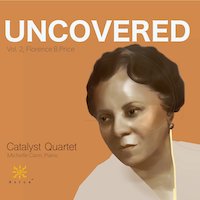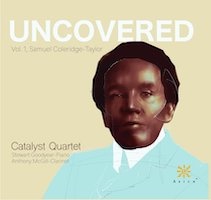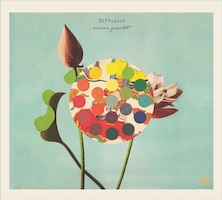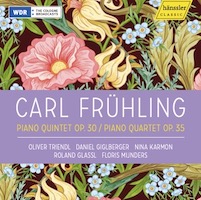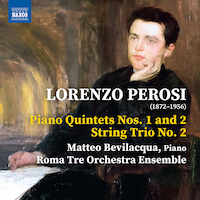String Theory 39.
|
Grant Chu Covell [September 2022.]
“Uncovered, Vol. 2: Florence B. Price.” Florence Beatrice PRICE: Piano Quintet in A minor (ca. 1935)1; Negro Folksongs in Counterpoint for String Quartet (ca. 1947)2; String Quartet No. 2 in A minor (1935)3; Five Folksongs in Counterpoint for String Quartet (1951)4; String Quartet in G Major (1929, unfinished)5; Piano Quintet in E minor (1936, unfinished)6. Catalyst Quartet1,2,3,4,5,6: Karla Donehew Perez, Abi Fayette (vln), Paul Laraia (vla), Karlos Rodriguez (vlc), Michelle Cann1,6 (pno). Azica ACD-71346 (digital only) (www.azica.com). Exceptionally fine performances of the Price quartets and quintets set a high bar for others to follow. This program warrants an in-depth listen, not just to be more inclusive and expand the diversity of our listening, but because there are some remarkable moments: the melancholy ostinato anchoring the A-minor string quartet’s first movement (published as Quartet No. 2), the unexpected modulations concluding Swing Low, Sweet Chariot, and the initial phrases of the incomplete G major string quartet. The four-movement Piano Quintet is Romantic and tuneful. Dvořák would have recognized the incorporation of spirituals, but perhaps not the Rachmaninoff-like twists. In her mature works, Price (1887-1953) included a Juba (an African-American dance that originated on plantations and sung by slaves) in the spot we usually see a Scherzo. Sometimes the final movement would be labelled a Scherzo or an upbeat Finale. The Piano Quintet finishes with a Juba and a quick Scherzo (which behaves as if the start of a Rondo). Like the Piano Quintet, the A minor String Quartet begins with a substantial first movement which takes the greatest design and harmonic risks. Price’s piling on of thirds and fourths in her transitions is not far from Schoenberg’s innovations in Verklärte Nacht. The quartet concludes with a Juba and a rondo Finale alternating fast and slow. Nine folksong settings live in two groups. The 1947 collection of four labels them as “Negro,” the later five-number set, from 1951, simply as “Folksongs.” We may think of Ives who highlighted popular melodies, but Ives incorporated without developing. A better analogy would be Janáček or Tchaikovsky who fashioned wholly new fabric, countermelodies and personal touches. Some settings are fugal and intricate, others slow and emotional. Price deftly pushes the harmonization in surprising new directions, momentarily losing the tune or reaching different keys. Swing Low, Sweet Chariot concludes the Five Folksongs and contains the most innovation. The collection concludes with two unfinished works, or rather, a few related movements which might have evolved into larger works. The Allegro of an unfinished G major string quartet is particularly striking with its harmony. Except for the A minor Piano Quintet and Five Folksongs in Counterpoint these are first recordings.
“Uncovered, Vol. 1: Samuel Coleridge-Taylor.” Samuel COLERIDGE-TAYLOR: Piano Quintet in G minor, Op. 1 (1893)1; 5 Fantasiestücke for String Quartet, Op. 5 (1895)2; Clarinet Quintet in F-sharp minor, Op. 10 (1895)3. Catalyst Quartet1,2,3: Karla Donehew Perez, Abi Fayette (vln), Paul Laraia (vla), Karlos Rodriguez (vlc), Stewart Goodyear1 (pno), Anthony McGill3 (clar). Azica ACD-71336 (1 CD) (www.azica.com). Coleridge Taylor (1875-1912) was a precocious student when these works were written. The Op. 1 Piano Quintet looks admiringly at Brahms and Dvořák and is given lively advocacy by the Catalyst Quartet and pianist Goodyear. The fantasy pieces reflect the measure of Schumann, but perhaps Coleridge-Taylor’s teacher Stanford is the closer model. The Clarinet Quintet is passionate and distinctive, in a four-movement classical structure. The Catalyst Quartet and their guests play with gusto pieces that ought to be more familiar.
“Diffusion.” Leoš JANÁČEK: String Quartet No. 2, “Intimate Letters.” (1928). Karol SZYMANOWSKI: String Quartet No. 2, Op. 56 (1927). Maurice RAVEL: String Quartet (1903). The Verona Quartet: Jonathan Ong, Dorothy Ro (vln), Abigail Rojansky (vla), Jonathan Dormand (vlc). Azica ACD-71339 (1 CD) (www.azica.com). This polished program counterbalances Ravel against Janáček and Szymanowski. The Verona’s Janáček throws caution to the wind, but with confidence and precisely piloted rhythms. These are shining and passionate “Letters.” We can hear declarations and secrets embedded in the motives. Szymanowski’s No. 2 is the standout. Mysterious and sultry, there’s a coarseness suggesting barbarism, but then a melody or harmony will offer ardent Romanticism. The Veronas invite us to play close attention. Szymanowski was gifted, but Janáček was the better quartet writer. Ravel is treated like a feared uncle; this is a safe reading. It’s delightful to hear gestures which Janáček and Szymanowski would leverage decades later. If Berg or Bartók had been programmed instead, I suspect we would have heard more raw emotion and vibrance.
Carl FRÜHLING: Piano Quintet in F-sharp minor, Op. 30 (1892)1; Piano Quartet in D major, Op. 35 (ca. 1892-1911)2. Oliver Triendl1,2 (pno), Daniel Giglberger1,2, Nina Karmon1 (vln), Roland Glassl1,2 (vla), Floris Mijnders1,2 (vlc). Hännsler Classic HC21062 (1 CD) (www.haensslerprofil.de). Not much can be gathered about Frühling (1868-1937). Trained in Vienna, he had difficulty establishing himself. In the 1930s, his Jewish ancestry diminished his prospects, and he died in obscurity. He did play piano with the Rosé Quartet and Egon Wellesz was a student. For all of Frühling’s ardent Romanticism and tidiness, the Quintet’s robust impression quickly fades. While the piano keeps busy, the strings often double left-hand notes, effectively vanishing into the texture. Op. 30’s Scherzo does present a catchy motive but is not substantially developed. In the Finale, Frühling timidly starts something fugal (in once case doubling piano and viola). If the Quintet’s string writing is simplistic, the Quartet is intricate and chromatic, and the strings have independent parts. The Quartet is assuredly a later composition, but undatable. A manuscript was in the possession of the Flonzaley Quartet and was prepared for publication ahead of this release.
Lorenzo PEROSI: Piano Quintet No. 1 in F major (1930)1; Piano Quintet No. 2 in D minor (1931)2; String Trio No. 2 in A minor (1928)3. Matteo Bevilacqua1,2 (pno), Roma Tre Orchestra Ensemble: Leonardo Spinedi1,2,3, Hinako Kawasaki1,2 (vln), Lorenzo Rundo1,2,3 (vla), Angelo Maria Santisi1,2,3 (vlc). Naxos 8.574375 (1 CD) (www.naxos.com). Fashions come and go, and we have lost track of this prolific early 20th-century Italian composer. Puccini’s assessment bears repeating: “…there is more music in Perosi’s head than in mine and Mascagni’s put together.” Perosi was an ordained priest whose appointments included leadership of the Cappella Marciana at San Marco’s Basilica in Venice and the Sistine Choir at the Vatican. In some circles Perosi’s sacred music will be more familiar than either his orchestral or chamber works. Perosi (1872-1956) wrote four piano quintets in the two years 1930 and ’31. Built to follow a fast-slow-fast three-movement format, these first two balance strings against piano in a predominantly conversational style with atmospheric diminished chords, pizzicato, pedalpoints and ostinatos. Themes flow but may be hard to recall. Imagine a hurried Fauré responding to something bright heard at a salon. The Trio succeeds best given its homogeneity and that Perosi is comfortable alternating who may accompany or provide melody. Perosi achieves more gravity with the three strings than he does with the combined quintet.
[More Grant Chu Covell, String Theory]
[Previous Article:
Used Bin Troll Tweets JJJ.]
[Next Article:
A Picture is Worth A Thousand Words]
|
